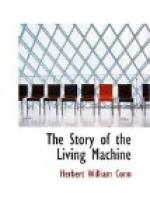The obstacles in the way of these experiments do not particularly concern us, but the general results are of the greatest significance for our purpose. While, for manifest reasons, it has not been possible to carry on these experiments for any great length of time, and while the results have not yet been very accurately refined, they are all of one kind and teach unhesitatingly one conclusion. So far as concerns measurable energy or measurable material, the body behaves just like any other machine. If the body is to do work in this respiration apparatus, it does so only by breaking to pieces a certain amount of food and using the energy thus liberated, and the amount of food needed is proportional to the amount of work done. When the individual simply walks across the floor, or even rises from his chair, this is accompanied by an increase in the amount of food material broken up and a consequent increase in the amount of refuse matter eliminated and the heat given off. The income and outgo of the body in both matter and energy is balanced. If, during the experimental period, it is found that less energy is liberated than that contained in the food assimilated, it is also found that the body has gained in weight, which simply means that the extra energy has been stored in the body for future use. No more energy can be obtained from the body than is furnished, and for all furnished in the food an equivalent amount is regained. There is no trace of any creation or destruction of energy. While, on account of the complexity of the experimenting, an absolutely strict balance sheet cannot be made, all the results are of the same nature. So far as concerns measurable energy, all the facts collected bear out the theoretical conception that the living body is to be regarded as a machine which converts the potential energy of chemical composition, stored passively in its food, into active energy of motion and heat.
It is found, however, that the body is a machine of a somewhat superior grade, since it is able to convert this potential energy into motion with less loss than the ordinary machine. As noticed above, in all machines a portion of the energy is converted into heat and rendered unavailable by radiating into space. In an ordinary engine only about one-fifteenth of the energy furnished in the coal can be regained in the form of motive power, the rest being radiated from the machine as heat. Some of our better engines to-day utilize a somewhat larger part, but most of them utilize less than one-tenth. The experiments with the living body in the respiration apparatus above described, give a means of determining the proportion of the energy furnished in the form of food which can be utilized in the form of motive force. This figure appears to be decidedly larger than that obtained by any machine yet devised by man.
The conclusion of the matter up to this point is then clear. If we leave out of account the phenomena of the nervous system, which we shall consider presently, the general income and outgo of the body as concerns matter and energy is such that the body must be regarded as a machine, which, like other machines, simply transforms energy without creating or destroying it. To this extent, at least, animals conform to the law of the conservation of energy and are veritable machines.




